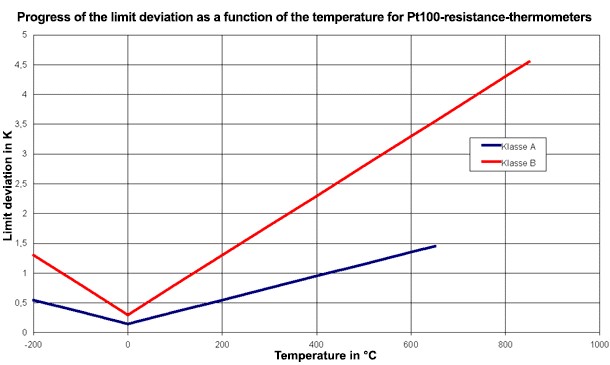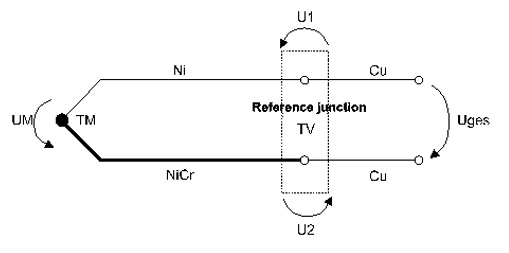
temperature
general information
Temperature is a measure for the intensity of heat. The basic unit is Kelvin with the abbreviation K. The K is the 273.16th part of the thermo-dynamic temprature of the triple point of pure water. The triple point (= 273.16 K) describes the condition of water in which it exists in the solid, liquid and gaseous phase simultaneously. The triple point is 0.01 K higher than the melting point of water at an absolute pressure of 1,013.25 mbar and for this almost identical with it. The zeropoint of the thermo-dynamic temperature (0 K) is the lowest temperature which can be reached theoretically.
As legal temperature scale in the European states the Celsius scale is permitted in addition to the Kelvin scale. The measuring unit is grade Celsius with the abbreviation °C. The Celsius scale deviates from the Kelvin scale by 273.15 K so that 0°C corresponds with the melting point and 100°C correspond with the boiling point of pure water.
In the meteorological field you are operating with the Celsius scale.
- example 250 K = (250 - 273.15)°C = -23.15°C
- example 50°C = (50 + 273.15) K = 323.15 K
electrical thermometers
resistance thermometers
Resistance thermometers made of metal change their electrical resistance in dependance on the temperature. The changes of the electrical resistance under influence of temperature is caused by the conducting mechanism of the metalls. The conductivity of metals bases on the electrones that are free to move in the atomic lattice. Their number and kinetic energy depends on the temperature. If energy is fed to the metal atomics by increasing the temperature they swing with a correspondingly higher amplitude and frequency. This moving of the electrones is opposed more and more by a resistance which corresponds to the electrical resistance. Since the electrical resistance increases proportionally to the temperature it is called a positive temperature coefficient.
Platinum is the metal with the best characteristics and therefor the Pt resistance thermometer is the most important one in the temperature measuring field. Further metals being used for measuring temperature are copper (Cu), nickel (Ni) or molybdenum (Mo).
The platinum resistance thermometer is described in details in the EN 60741. Most often the so-called Pt100 resistance thermometer is used. This thermoemter has at t = 0°C a nominal resistance of R = 100 W and obeys to the following equation:
- within in the measuring range -200°C to 0°C:

- within in the measuring range -0°C to +850°C:

- whereas applies:
A= 3.9083 x 10-3 °C-1
B= -5.775 x 10-7 °C-2
C= -4.183 x 10-12 °C-4
The Pt100 resistance thermometers are seperated in two accuracy classes:
- class A: (0.15 + 0.002 | t | ) °C
- class B: (0.30 + 0.005 | t | ) °C

thermocouples
The measuring principle of a thermocouple is based on the effect discovered by Seebeck: at the ends oft wo wires made of different materials a voltage is generated, if the temperature at the junction of two different materials differs from the one at the clamps of the measuring device.
Due to scientific expertise this effect bases on a material specific character of electrically conductive materials. Inside a wire the density of the electrones changes (volume diffusion effect), if a temperature gradient exists over the wire. The accumulation of the electrones becomes closer at lower temperatures.
If a thermocouple made of two suitable materials, e.g. NiCr and Ni is used, the thermoelectric voltage of the material matching can be measured. The following chart shows the thermoelectric voltage series against platinum at a temperature of 100°C at the meausring site and a temperature of the reference junction of 0°C.
| material | voltage value in mV |
| tellurium | 50 |
| silicium | 45 |
| silit | 27 |
| antimony | 4.8 |
| nickel-chrome (85Ni-10Cr) | 2.55 |
| iron | 1.9 |
| platinum-rhenium | 1.5 |
| molybdenum, uranium | 1.2 |
| brass | 1.1 |
| iridium-rhodium (40IR, 60RH) | 1.0 |
| tungsten, stainless steel (V2A) | 0.8 |
| copper | 0.75 |
| silver, gold, zinc | 0.7 |
| Manganin (86Cu, 12Mn, 2Ni) | 0.68 |
| rhodium | 0.65 |
| iridium-rhodium (40Ir, 66Rh) | 0.64 |
| platinum-rhodium (10 %) | 0.64 |
| ibidium | 0.63 |
| phosphor bronze | 0.52 |
| tantalum, caesium | 0.5 |
| lead, iridium-rhodium | 0.45 |
| aluminium, magnesium, zinc | 0.4 |
| graphite | 0.2 |
| platinum, mercury | 0.0 |
| thorium | -0.1 |
| sodium | -0.21 |
| palladium | -0.3 |
| potassium | -0.94 |
| nickel silver (Cu, Ni, Zn) | -1.0 |
| nickel | -1.55 |
| cobalt | -1.6 |
| constants (55Cu, 45Ni) | -3.5 |
| bismuth, vertical to axis | -5.2 |
| bismuth, parallel to axis | -7.7 |
Thermocouples and compensating cables are defined by colour codes. Regrettably these codes depend on their country.
At thermocouples two wires of different materials are connected at the measuring point. If these so-called thermowires are connected with copper wires this transition point is called junction. The thermoelectrical voltage measured at this junction is directly proportionally to the temperature difference between measuring site and junction. The example below shows a thermocouple type K.

You are receiving the thermoelectrical voltage that is proportional to the temperature by subtracting the thermoelectrical voltage at the junction. For the sake of simplicity the junction temperature is thought as zero so all thermocouples have got a thermoelectrical voltage of 0 mV then and for this the voltage at the measuring site correponds with the total voltage.
semiconductors
Resistance thermometer on basis of semiconductors use the temperature-dependent changes of the electrical resistance of semiconducting, mostly ceramic materials for measuring the temperature.
They are containing:
- PTC resistors (PTC)
- negative temperature coefficient thermistors (NTC)
- silicium measuring resistances
A PTC (PTC-resistance) is a temperature-dependent semiconducting resistance whose resistance value increases rapidly when reaching a certain reference temperature. Usually you are finding the corresponding resistance value, the transition temperature and the maximum operation voltage for a certain reference temperature in the producers‘ information. PTC resistors are made of doped polycristalline ceramics on basis of bariumnitrate.
Negative temperature coefficient thermistors are frequently called thermistors or NTC resistances, too. The resistance of NTCs depends nearly exponentially on the temperature. NTCs consist of polycristalline mixed oxide ceramics. They are indicated by the producers with characteristics curves. For the course of these characteristic curves the following relation applies approximately:
 , whereas applies:
, whereas applies:- T: temperature in K
- TD: reference temperature in K
- RT: resistance at temperature T
- RTo: resistance at temperature To
- B: constant in K depending on form and material
Spreading resistance sensors (SPS) have got a positive temperature coefficient. The characteristics curve is distinguished by a low non-linearity which can be compensated by a simple switching technology.
mechanical thermometers
The mechanical temperature measuring processes are based on the spacial expansion of gaseous, liquid or solid materials influenced by temperature. If the functional dependence of the thermal expansion of a material known from physical calculations or empirical processes, this material character can be used for measuring temperature.
bimetal thermometers
The temperature-sensitive sensor element is a bimetal strip performed as a spiral spring or screw spring. A bimetal strip is a measuring element consisting of two materials with different coefficients of thermal expansion. The material coefficients are chosen so that the difference between the coefficients of thermal expansion is as large as possible. The angle of revolution of a bimetal coil is changing in dependance on the temperature.
The relation between angle of revolution and temperature can be described by the following formula:

- a: specific thermal expansion
- l: length of bimetal strip
- s: thickness of bimetal strip
At gas pressure spring thermometers the total closed system is filled with an inert gas or gas mixture. The temperature-dependent change of gas pressure can be indicated via a capillary line and the elastic measuring spring.
By means of the Van-der-Waals equation of state the relation between filling pressure and temperature is calculated.
gas pressure thermometers
Liquid glass thermometers are a wide-spread type of expansion thermometers. The mode of operation is based on the thermal expansion of liquids. By varying the volume of the thermometer pot, the sensivity of the thermometer can be influenced. The most popular thermometer liquids are mercury, gallium and alcohol.
measurement of thermal radiation by pyrometer
As well as heat exchange through conduction and convection, solids also exchange heat with their surrounding environment through radiation. The heat radiation of a measurement object is optically filtered and concentrated on a radiation detector. The electrical reaction consists of a change in resistance, voltage or current of the radiation detector, directly induced, or induced indirectly by an increase in temperature, dependent on the principle applied. The electrical change is amplified, measured and processed (see also VDI 3511, Page 4).
listing of further methods for measuring temperature (not detailled)
- optical measuring processes (determination of the intensity or wavelength of the electromagnetic radiation of a body)
- temperature measurement colours (physical effects of materials changing their colour dependent on temperature)
- liquid crystals (for indication of surface temperatures and optical reprensenting of temperature fields)
- quartz crystal temperature sensors (the resonance frequency is changes dependent to temperature)
- acoustic measurement processes (temperature-dependent speed of propagation of sound)
- noise thermometers (temperature dependence of mean electron speed - Brown movement)
- capacitive temperature sensors (dielectricity constant dependent on temperature)
- inductive temperature sensors (magnetic moment dependent on temperature)
